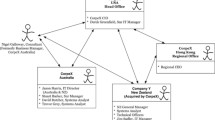Abstract
Implementing new operating procedures into organisations is problematic. It requires consideration of the socialisation processes needed to encourage implementers to creatively adopt and adapt the new procedure. The four main explanations of why organisational change occurs are teleology (group emerged action), evolution, dialectic and life cycles (growth stages). These have been mapped onto the corresponding organisational socialisation processes of job rotation, benchmarking with continuous improvement, competition and the use of champions. It has been claimed that successful implementation requires a mix of all four of these processes. This paper tests that claim by comparing the implementation of Total Quality Management into 32 independent and geographically dispersed bulk grain handling sites located around South Australia. Using Boolean Analysis it was found that successful implementation was achieved using either (a) self managed problem-solving teams and a review teams or, (b) champions with job rotation and site visits. Both of these mixes of socialisation processes worked; doing both was not necessary. The implications of this finding are discussed.
Similar content being viewed by others
References
Aiman-Smith L and Green SG (2002). Implementing new manufacturing technology: The related effect of technology characteristics and user learning activities. Acad Mngt J 45: 421–430.
Barley SR (1986). Technology as an occasion for structuring. Admin Sci Quart 31: 78–108.
Brown JS and Duguid P (2000). Mysteries of the region: Knowledge dynamics in Silicon Valley. In: Lee M (ed). Silicon Valley. Stanford Books: Stanford, CA.
Brown S and Bessant J (2003). The manufacturing strategy-capabilities links in mass customisation and agile manufacturing—an exploratory study. Int J Opns Prod Mngt 23: 707–730.
Butcher D and Atkinson S (2001). Stealth, secrecy and subversion: The language of change. J Organ Change Mngt 14: 554–569.
Camazine S, Deneubourg J-L and Franks NR (2001). Self-organization in Biological Systems. Princeton University Press: Princeton, NJ.
Churchman CW and Schainblatt AH (1965). The researcher and the manager: A dialectic of implementation. Mngt Sci 11: 69–87.
Delarue A, Hootegem V, Procter SG and Burridge M (2007). Teamworking and organizational performance. Int J Mngt Rev 10: 127–148.
Desombre T, Kelliher C, Macfarlane F and Ozbilgin M (2006). Re-organizing work roles in health care: Evidence from the implementation of functional flexibility. Brit J Mngt 17: 139–151.
Fiss PC (2007). A set theoretic approach to organizational configurations. Acad Mngt Rev 32: 1180–1198.
Francis D, Bessant J and Hobday M (2003). Managing radical organisational transformation. Mngt Decis 41: 18–31.
Francis G and Holloway J (2007). What have we learned? Themes from the literature on best-practice benchmarking. Int J Mngt Rev 9: 171–189.
Girard R (1977). Violence and the Sacred. Johns Hopkins University Press: Baltimore, MD.
Haney C, Banks WC and Zimbardo PG (1973). Interpersonal dynamics in a simulated prison. Int J Crim Penol 1: 69–97.
Hatch MJ and Ehrlich SB (1993). Spontaneous humour as an indicator of paradox and ambiguity in organizations. Organ Stud 14: 505–526.
Heidegger M (2008). Being and Time. Harper Perennial Classics: New York.
Kanter RM (1983). The Change Masters. Unwin: London.
Katzenbach J and Smith D (1993). The discipline of teams. Harvard Business Review, March–April, pp 111–119.
Kluge J, Stein W and Licht T (2001). Knowledge Unplugged: The Mckinsey & Company Global Survey on Knowledge Management. Palgrave, Basingstoke, UK.
Likert R (1932). A technique for the measurement of attitudes. Arch Psychol 140: 1–55.
Markus ML and Bjørn-Andersen N (1987). Power over users: Its exercise by professionals. Commun ACM 30: 498–504.
Martin C, Metcalfe M and Harris H (2009). Developing an implementation capacity: Justifications from prior research. J Opl Res Soc 60: 859–868.
Milgram S (1992). The Individual in a Social World: Essays and Experiments. McGraw-Hill: New York.
Mohr LB (1982). Explaining Organizational Behaviour. Jossey-Bass: San Francisco, CA.
Palmer I and Dunford R (2008). Organizational change and the importance of embedded assumptions. Brit J Mngt 10: 20–32.
Polanyi M (1966). The Tacit Dimension. Doubleday & Co: Garden City, NY.
Ragin CC (1987). The Comparative Method. University of California Press: Berkeley, CA.
Ragin E (1994). Diffusion of Innovations. Free Press: New York.
Rost KK, Hölzle K and Gemunden HG (2007). Promoters or champions? Schmalenbach Bus Rev 59: 340–363.
Schneider B, Goldstein HW and Smith DB (1995). The ASA framework: An update. Pers Psychol 48: 747–753.
Schwarz GM and Huber GP (2008). Challenging organizational change research. Brit J Mngt 19: 1–6.
Seo M-G and Creed DWE (2002). Institutional contradictions, praxis and institutional change: A dialectical perspective. Acad Mngt Rev 27: 222–247.
Sexton C (1994). Self-managed work teams: TQM technology at the employee level. J Organ Change Mngt 7: 45–52.
Smith A (2006 reprint). The Wealth of Nations. Book Jungle: London.
Tidd J, Bessant J and Pavitt K (2001). Managing Innovation: Integrating Technological Market and Organisational Change. Wiley: Chichester, UK.
Todorova G and Durisin B (2007). Absorptive capacity: Valuing a reconceptualization. Acad Mngt Rev 32(3): 774–786.
Tsang E and Williams J (2007). Generalization and Hume's problem of induction: Misconceptions and clarifications. Social Sciences and Humanities Working Paper Series, https://mercury.smu.edu.sg/rsrchpubupload/7853/InfoSysResearchSubmission.pdf, accessed September 2008.
Tyre M and Von Hippel E (1997). The situated nature of adaptive learning in organisations. Organ Sci 8: 71–74.
Van De Ven A and Poole MS (1995). Explaining development and change in organizations. Acad Mngt Rev 20: 510–540.
Walsham G (1995). Interpretive case studies in IS research: Nature and method. Eur J Inform Syst 4: 74–81.
Weber M (1997). The Theory of Social and Economic Organization. Free Press: New York.
Weick KE (2006). The role of imagination in the organizing of knowledge. Eur J Inform Syst 15: 446–452.
Wenger EC and Snyder WM (2000). Communities of practice. Harvard Business Review, January, pp 139–145.
Author information
Authors and Affiliations
Corresponding author
Rights and permissions
About this article
Cite this article
Martin, C., Metcalfe, M. Implementation processes: a Boolean analysis. J Oper Res Soc 62, 21–28 (2011). https://doi.org/10.1057/jors.2009.172
Received:
Accepted:
Published:
Issue Date:
DOI: https://doi.org/10.1057/jors.2009.172




